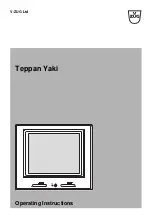
Preventing material damage
en
17
The appliance becomes hot during operation.
▶
Allow the appliance to cool down before
cleaning.
WARNING ‒ Risk of electric shock!
Incorrect repairs are dangerous.
▶
Repairs to the appliance should only be
carried out by trained specialist staff.
▶
Only use genuine spare parts when repair-
ing the appliance.
▶
If the power cord of this appliance is dam-
aged, it must be replaced with a special
connection cable, which is available from
the manufacturer or his Customer Service.
If the appliance or the power cord is dam-
aged, this is dangerous.
▶
Never operate a damaged appliance.
▶
Never operate an appliance with a cracked
or fractured surface.
▶
An ingress of moisture can cause an electric
shock.
▶
Do not use steam- or high-pressure clean-
ers to clean the appliance.
The insulation on cables of electrical appli-
ances may melt if it touches hot parts of the
appliance.
▶
Never bring electrical appliance cables into
contact with hot parts of the appliance.
WARNING ‒ Risk of injury!
Saucepans may suddenly jump due to liquid
between the saucepan base and the hotplate.
▶
Always keep hotplates and saucepan
bases dry.
WARNING ‒ Risk of suffocation!
Children may put packaging material over
their heads or wrap themselves up in it and
suffocate.
▶
Keep packaging material away from chil-
dren.
▶
Do not let children play with packaging ma-
terial.
Children may breathe in or swallow small
parts, causing them to suffocate.
▶
Keep small parts away from children.
▶
Do not let children play with small parts.
2
Preventing material damage
ATTENTION!
Rough pot and pan bases will scratch the ceramic.
▶
Check your cookware.
Boiling pans dry may damage cookware or the appli-
ance.
▶
Never place empty pans on a heated hotplate or al-
low to boil dry.
Incorrectly positioned cookware can cause the appli-
ance to overheat.
▶
Never place hot pots or pans on the controls or the
hob surround.
Damage can occur if hard or pointed objects fall onto
the hob.
▶
Do not let hard or pointed objects fall onto the hob.
Non heat-resistant materials will melt on heated hot-
plates.
▶
Do not use oven protective foil.
▶
Do not use aluminium foil or plastic containers.
2.1 Overview of the most common damage
Here you can find the most common types of damage
and tips on how to avoid them.
Damage Cause
Measure
Stains
Food boiling
over
Remove boiled-over food
immediately with a glass
scraper.
Stains
Unsuitable
cleaning
products
Only use cleaning
products that are suitable
for glass ceramic.
Scratch
es
Salt, sugar or
sand
Do not use the hob as a
work surface or storage
space.
Scratch
es
Rough pot or
pan bases
Check your cookware.
Discol-
ouration
Unsuitable
cleaning
products
Only use cleaning
products that are suitable
for glass ceramic.
Discol-
ouration
Pan abrasion,
e.g. aluminium
Lift pots and pans to
move on the hob.
Blisters
Sugar or food
with a high
sugar content
Remove boiled-over food
immediately with a glass
scraper.
Summary of Contents for T16 K40 Series
Page 2: ...cm 2 T16 K40 TL16EK 14 5 14 5 18 21 T16 K50 14 5 14 5 18 21 12...
Page 29: ......
Page 30: ......
Page 31: ......
















































